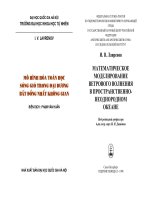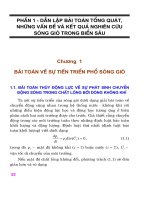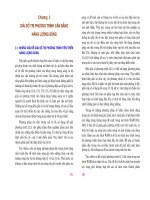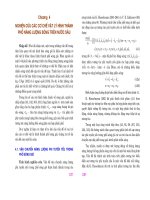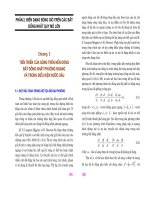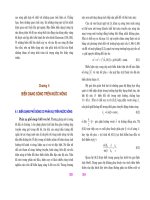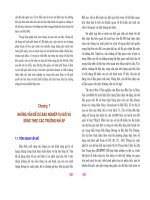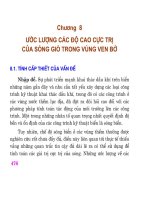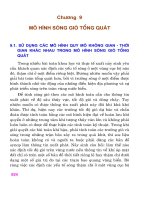Mô hình hóa Toán học (MATHEMATICAL APPLICATION AND MODELLING YEAR BOOK 2010)
Bạn đang xem bản rút gọn của tài liệu. Xem và tải ngay bản đầy đủ của tài liệu tại đây (15.01 MB, 351 trang )
MATHEMATICAL
APPLICATIONS AND
MODELLING
Yearbook 2010
Association of Mathematics Educators
7798tp.zhangji.03.10.ls.2.indd 2
3/18/10 3:09:34 PM
This page intentionally left blank
MATHEMATICAL
APPLICATIONS AND
MODELLING
Yearbook 2010
Association of Mathematics Educators
editors
Berinderjeet Kaur
Jaguthsing Dindyal
dy
dx = ax 2
+
National Institute of Education, Singapore
c
World Scientific
7798tp.zhangji.03.10.ls.2.indd 1
3/18/10 3:09:34 PM
Published by
World Scientific Publishing Co. Pte. Ltd.
5 Toh Tuck Link, Singapore 596224
USA office: 27 Warren Street, Suite 401-402, Hackensack, NJ 07601
UK office: 57 Shelton Street, Covent Garden, London WC2H 9HE
British Library Cataloguing-in-Publication Data
A catalogue record for this book is available from the British Library.
MATHEMATICAL APPLICATIONS AND MODELLING
Yearbook 2010, Association of Mathematics Educators
Copyright © 2010 by World Scientific Publishing Co. Pte. Ltd.
All rights reserved. This book, or parts thereof, may not be reproduced in any form or by any means,
electronic or mechanical, including photocopying, recording or any information storage and retrieval
system now known or to be invented, without written permission from the Publisher.
For photocopying of material in this volume, please pay a copying fee through the Copyright
Clearance Center, Inc., 222 Rosewood Drive, Danvers, MA 01923, USA. In this case permission to
photocopy is not required from the publisher.
ISBN-13 978-981-4313-33-9
ISBN-13 978-981-4313-34-6 (pbk)
Printed in Singapore.
ZhangJi - Math'l Applns & Modelling.pmd
1
4/13/2010, 9:25 AM
Contents
Part I
Introduction
1
Chapter 1
A Prelude to Mathematical Applications and
Modelling in Singapore Schools
Berinderjeet KAUR
Jaguthsing DINDYAL
3
Part II
Applications and Modelling in Primary School
19
Chapter 2
Communities of Mathematical Inquiry to Support
Engagement in Rich Tasks
Glenda ANTHONY
Roberta HUNTER
21
Chapter 3
Using ICT in Applications of Primary School
Mathematics
Barry KISSANE
40
Chapter 4
Application Problems in Primary School
Mathematics
YEO Kai Kow Joseph
63
Chapter 5
Collaborative Problem Solving as Modelling in the
Primary Years of Schooling
Judy ANDERSON
78
Chapter 6
Word Problems and Modelling in Primary School
Mathematics
Jaguthsing DINDYAL
94
v
vi
Mathematical Applications and Modelling
Chapter 7
Mathematical Modelling in a PBL Setting for
Pupils: Features and Task Design
CHAN Chun Ming Eric
112
Chapter 8
Initial Experiences of Primary School Teachers
with Mathematical Modelling
NG Kit Ee Dawn
129
Part III
Applications and Modelling in Secondary School
149
Chapter 9
Why Study Mathematics? Applications of
Mathematics in Our Daily Life
Joseph Boon Wooi YEO
151
Chapter 10
Using ICT in Applications of Secondary School
Mathematics
Barry KISSANE
178
Chapter 11
Developing Pupils’ Analysis and Interpretation of
Graphs and Tables Using a Five Step Framework
Marian KEMP
199
Chapter 12
Theoretical Approaches and Examples for
Modelling in Mathematics Education
Gabriele KAISER
Christoph LEDERICH
Verena RAU
219
Chapter 13
Mathematical Modelling in the Singapore
Secondary School Mathematics Curriculum
Gayatri BALAKRISHNAN
YEN Yeen Peng
Esther GOH Lung Eng
247
Contents
vii
Chapter 14
Making Decisions with Mathematics
TOH Tin Lam
258
Chapter 15
The Cable Drum – Description of a Challenging
Mathematical Modelling Example and a Few
Experiences
Frank FÖRSTER
Gabriele KAISER
276
Chapter 16
Implementing Applications and Modelling in
Secondary School: Issues for Teaching and
Learning
Gloria STILLMAN
300
Part IV
Conclusion
323
Chapter 17
Mathematical Applications and Modelling:
Concluding Comments
Jaguthsing DINDYAL
Berinderjeet KAUR
325
Contributing Authors
336
This page intentionally left blank
Part I
Introduction
This page intentionally left blank
Chapter 1
A Prelude to Mathematical Applications
and Modelling in Singapore Schools
Berinderjeet KAUR
Jaguthsing DINDYAL
This chapter introduces the reader to the aims of mathematics
education in Singapore and the framework of the school
mathematics curriculum. It also sheds light on the intended
curriculum, specifically the emphasis placed on applications and
modelling in the framework since the last revision of the
curriculum. For the past two decades, the framework has
emphasised heuristics and thinking skills as problem-solving
processes and teachers are comfortable teaching for problem
solving and teaching about problem solving. Since 2007, teachers
have been faced with the challenge to embrace the process:
applications and modelling and expand their repertoire of means to
nurture mathematical problem solvers. Finally, it introduces the
reader to the chapters in the book, as it unfolds how each
contributes to the theme of the book: Mathematical applications and
modelling.
1 Introduction
In Singapore, mathematics is a compulsory subject for students from
primary one till end of secondary schooling. Some students have to do it
for 10 years while others for 11 years depending on their course of study
at the secondary school. The mathematics curriculum adopts a spiral
approach and has coherent aims. The aims stated specifically in the
3
4
Mathematical Applications and Modelling
syllabus documents of the Ministry of Education (2006a, p. 5; 2006b,
p. 1) are as follows:
•
•
•
•
•
•
•
•
Acquire the necessary mathematical concepts and skills for
everyday life and for continuous learning in mathematics and
related disciplines.
Develop the necessary process skills for the acquisition and
application of mathematical concepts and skills.
Develop the mathematical thinking and problem-solving skills
and apply these skills to formulate and solve problems.
Recognise and use connections among mathematical ideas, and
between mathematics and other disciplines.
Develop positive attitudes towards mathematics.
Make effective use of a variety of mathematical tools (including
information and communication technology tools) in their
learning and application of mathematics.
Produce imaginative and creative work arising from
mathematical ideas.
Develop the abilities to reason logically, communicate
mathematically, and learn cooperatively and independently.
It is apparent that the aims provide a focus for the intended
curriculum which is succinctly summarized in a framework, called the
framework of the school mathematics curriculum. This framework
summarises the essence of mathematics teaching and learning and serves
as a guide for the implementation of the curriculum. The intended
curriculum is presented as syllabus documents that outline the
philosophy of the syllabus and objectives of the curriculum along with
syllabus content for each level and course of study.
2 Framework of the School Mathematics Curriculum
The framework, shown in Figure 1, has mathematical problem solving as
its primary goal. Five inter-related components, namely, Concepts, Skills,
Processes, Attitudes, and Metacognition, contribute to the development
A Prelude to Mathematical Applications and Modelling in Singapore Schools
5
of mathematical problem-solving ability. The framework developed in
1990, underwent revisions in 2000 and 2006. Table 1 shows the
evolution of the component Processes in the framework from 1990 till
the present. The 1990, 2000 and 2006 syllabuses were implemented in
1991, 2001 and 2007 respectively.
Figure 1. Framework of the school mathematics curriculum
Table 1
Processes: 1991 – present
Processes
1991 - 2000
2001 - 2006
2007 - present
Heuristics
Heuristics
Reasoning, communication and connections
Deductive reasoning
Thinking skills
Applications and modelling
Inductive reasoning
Heuristics
Thinking skills
From Table 1, it is apparent that the revised syllabuses of 2006 have
placed emphasis on reasoning, communications and connections;
6
Mathematical Applications and Modelling
applications and modelling in addition to heuristics and thinking skills as
processes that should pervade the implementation of the mathematics
curriculum. Unlike heuristics and thinking skills, which have been a
part of the framework for almost two decades now, reasoning,
communications and connections, and applications and modelling have
been rather “new” in the proposed tool kits of teachers and for many a
challenge in some ways. In 2009, the Association of Mathematics
Educators and the Mathematics and Mathematics Education Academic
Group of the National Institute of Education organised a Mathematics
Teachers Conference with the theme Mathematical Applications and
Modelling. During the conference, several international and local
mathematics educators shared with participants, mainly mathematics
teachers, their understandings, knowledge and pedagogies related to
mathematical applications and modelling. This book showcases many of
the peer-reviewed and presented papers. The chapters of this book are
an invaluable resource for teachers and educators in Singapore and
elsewhere.
3 Mathematical Applications and Modelling
The syllabus documents of 2006 (Ministry of Education, 2006a; 2006b)
for both primary and secondary schools, exemplify the process:
applications and modelling as follows:
Application and Modelling play a vital role in the development of
mathematical understanding and competencies. It is important that
students apply mathematical problem-solving skills and reasoning
skills to tackle a variety of problems, including real-world problems.
Mathematical modelling is the process of formulating and improving
a mathematical model to represent and solve real-world problems.
Through mathematical modelling, students learn to use a variety
of representations of data and to select and apply appropriate
mathematical methods and tools in solving real-world problems. The
opportunity to deal with empirical data and use mathematical tools
A Prelude to Mathematical Applications and Modelling in Singapore Schools
7
for data analysis should be part of learning at all levels. (Ministry of
Education, 2006a, p. 8; 2006b, p. 4)
The above does not appear to make any distinction between
application and modelling but emphasise “solving real-world problems”.
Stillman in chapter 16 of this book makes an excellent and meaningful
distinction between application and modelling. She states that
In mathematical applications the task setter starts with mathematics
and reaches out to reality. A teacher designing such a task is
effectively asking: Where can I use this particular piece of
mathematical knowledge? This leads to tasks that illustrate the use of
particular mathematics content. They are a useful bridge into
modelling but are not modelling in themselves. (p. 305)
With mathematical modelling on the other hand, the task setter starts
with reality and looks to mathematics before finally returning to
reality to judge the usefulness and desirability of the mathematical
model for description or analysis of a real situation. (p. 306)
From the syllabus documents it is apparent that the emphasis on
applications and modelling is for all levels of schooling. Hence, the
nature of applications and modelling tasks must be related to the
mathematical knowledge of the group of students for whom the tasks are
intended.
3.1 Primary level
In the primary school, it is heartening to note that students solve fairly
difficult mathematical tasks as problem solving is the goal of the
curriculum. Generally, the more challenging non-routine problems at this
level can be considered as application problems. The intent of such tasks
is to develop higher order thinking skills among the students. Textbooks,
used in Singapore primary schools, contain both routine problems for
exercises and non-routine problems for students to apply their knowledge
8
Mathematical Applications and Modelling
of mathematics in new situations. However, in the textbooks, the nonroutine problems are not labelled as application problems.
Since the advent of the mathematics curriculum for the New
Education System in the 1990s, there has been great emphasis on
thinking skills and problem solving heuristics, shown in Table 2.
Table 2
Thinking skills and heuristics for problem solving
Thinking Skills
Problem-Solving Heuristics
Classifying
Act it out
Comparing
Use a diagram/model
Sequencing
Make a systematic list
Analysing parts and whole
Look for pattern(s)
Identifying patterns and relationships
Work backwards
Induction
Use before-after concept
Deduction
Use guess and check
Generalising
Make suppositions
Verifying
Restate the problem in another way
Spatial Visualisation
Simplify the problem
Solve part of the problem
Thinking of a related problem
Use equations
An example of a problem-solving task, students in the primary
school may do is as follows:
The handshake problem
At a party there were 10 people. If everyone at the party shakes
hands with everyone else, how many handshakes would there be?
There are various heuristics that can be used to solve this problem.
Figure 2 shows the solution of a primary school student who obtained the
solution by modelling the process, on paper in the form of a diagram, of
how the handshakes were made. The problem solver has in a way
executed the heuristic “act it out” on paper (see Kaur & Yeap, 2009a,
p. 311).
A Prelude to Mathematical Applications and Modelling in Singapore Schools
9
Given that the focus of the curriculum has been on the processes of
heuristics and thinking skills for the past two decades, teachers are more
comfortable with solving of problems using problem-solving heuristics
and thinking skills than applications and modelling. Teachers have
received extensive training on the use of problem-solving heuristics, so
much so, that the use of heuristics has been routinised through some
exemplar problems. Students have thus developed some standard
problem-solving procedures which are counter to the very idea of
developing problem-solving skills. Also, textbooks and other assessment
books provide a wide range of problems for students to practice and for
teachers to adapt and use for their instructional needs.
Figure 2. A student’s solution to the handshake problem
As claimed by Reusser and Stebler (1997), at the primary level,
students get to apply the mathematics that they have learned mostly
through the so-called word problems or story problems. It is no different
in the primary schools in Singapore. Students are exposed to word
problems very early. An example of one such word problem is:
10
Mathematical Applications and Modelling
Tom has $18. Jenny has twice as much. How much money do they
have altogether?
This word problem describes a seemingly real context for the child
who has to understand the context and use appropriate mathematical
operations to solve the problem. Such problems are common at the
primary level in the curriculum.
More challenging word problems at the primary level are known as
the infamous Model Method problems. An example of one such problem
is as follows:
Ali, Ryan and James collect stamps. Ali has 5 more stamps than
Ryan. James has 60% of what Ryan has. Given that James has half as
many stamps as Ali, how many stamps do they have altogether?
The above problem is usually solved by students using the Model
Method (see Ferrucci, Kaur, Carter & Yeap, 2008), a method that uses
rectangular blocks to represent quantities and make comparisons. For the
solution of all such problems, algebra is a viable alternative but students
in primary school do not have sufficient know-how of algebra to do so.
Yeo in his chapter: Application problems in primary school
mathematics, illuminates the characteristics of application problems and
thinking process of solving such problems. He also gives examples of
four types of application problems that primary mathematics teachers
may infuse in their lessons. Kissane in his chapter: Using ICT in
applications of primary school mathematics showcases how calculators,
computer software and the internet enhance the application of
mathematics in the primary school.
Modelling is not an aspect that is explicit in the primary school
curriculum in Singapore. However, students are exposed to various types
of models. Van de Walle (2004) claimed that a model for a mathematical
concept refers to any object, picture, or drawing that represents the
concept or onto which the relationship for that concept can be imposed.
The Singapore mathematics curriculum emphasises that teachers use
A Prelude to Mathematical Applications and Modelling in Singapore Schools
11
various types of models to illustrate mathematical concepts. For
example, base ten blocks for numbers or area models for fractions are
quite commonly used. The textbook series at the primary level however,
do not have other types of modelling tasks and consequently the
implementation of modelling in the classroom is left to individual
teachers. Dindyal in his chapter: Word problems and modelling in the
primary school mathematics explores the use of the modelling cycle in
the solution process of word problems and classifies word problems from
a modelling perspective. Chan in his chapter: Mathematical modelling
in a PBL setting for pupils: Features and task design presents
mathematical modelling as a problem-solving activity. He focuses on
PBL as an instructional approach and the design of modelling tasks for
such settings.
From the findings of TIMSS 2007 (Mullis, Martin & Foy, 2008) it is
apparent that grade 4 (primary 4) teachers in Singapore spend their
instructional time each week in the following ways. They have their
students solve problems (35%), listen to lecture-style explanations
(19%), review homework (14%), and take tests and quizzes (8%). They
also re-teach content and procedures that students have difficulty with
(11%), carry out classroom management tasks (6%), and other student
activities (5%). There is little doubt that most, if not all of the problems
students solve are of the “word problem” application type. On the
contrary, at most 5% of the instructional time may have been used for
some modelling activities. Modelling activities would require classroom
discourse and organisation of student groups that are orthogonal to
independent work or listening to lecture-style explanations.
Anthony and Hunter in their chapter: Communities of
mathematical inquiry to support engagement in rich tasks draw on
international and New Zealand classroom research. They claim when
using modelling and application tasks that involve collaborative activity
it is important that teachers ensure that group and classroom discussions
support reasoned participation by all students. Anderson in her chapter:
Collaborative problem solving as modelling in the primary years of
schooling draws some similarities and differences between problem
solving and modelling. She draws on appropriate examples and
12
Mathematical Applications and Modelling
establishes that collaborative problem solving which requires the use
of processes such as questioning, analysing, reasoning and evaluating
to solve particular tasks mirrors mathematical modelling. Teachers
themselves must experience mathematical modelling so as to understand
the needs of their students engaged in mathematical modelling. Ng in
her chapter: Initial experiences of primary school teachers with
mathematical modelling suggests that more scaffolding was necessary to
ease teachers into the implementation of such tasks in the primary
classrooms, particularly in nurturing mindset change of teachers towards
accepting multiple representations of a problem, diverse solutions, and
what constitutes as mathematical in the representations.
3.2 Secondary level
In the secondary school, students are exposed to a wider range of
mathematical topics, including some harder arithmetic topics. They gain
more expertise in the use of algebra and geometry. Every topic they are
taught culminates with application type of problems. Generally three
types of application problems can be identified. The first type involves
the application of mathematics from one content domain to another
within mathematics. For example, the student who factorises 391 by
writing it as 400 – 9 and using difference of two squares for factorisation
is demonstrating this type of application. The second type can be
considered as the application of mathematics in situations described as
real-life but otherwise as purely mathematical problems. Most of the
word problems used in mathematics falls in this category. The third type
is problems in authentic situations in which the solver uses the
mathematics that he or she knows to solve the problem in a real context.
For example, a student who is in a store and has to decide which one is a
better buy: a 400 g packet of biscuit or a 300 g packet of biscuit in a
grocery store, given the price of each type of packet is solving this third
type of application problem.
Students should demonstrate flexibility in solving all three types of
application problems. Most of the so-called application problems in
mathematics are of the first or second type. It is expected that students
A Prelude to Mathematical Applications and Modelling in Singapore Schools
13
through solving the first and second type of application problems would
be better prepared for solving the authentic problems (third type) that
they would meet in their own daily lives. YEO in his chapter: Why study
mathematics? Applications of mathematics in our daily life shares with
readers several applications of mathematical knowledge and processes
both in the workplace and outside the workplace. Examples in this
chapter are helpful for teachers to bridge the knowledge their students
construct during mathematics lessons and use of the knowledge in dailylife. Information and communication technology (ICT) provides tools for
both teaching and learning in all schools in Singapore. Kissane in his
chapter: Using ICT in applications of secondary school mathematics
showcases how calculators, computer software and the internet enhance
the application of mathematics in the secondary school. In addition, he
also gives examples of how ICT tools may be used for simulations and
modelling.
Just like their counterparts in the primary school, teachers in
secondary schools are also more comfortable with problem-solving
heuristics and thinking skills than applications and modelling. They too
have received extensive training on the use of problem-solving
heuristics, so much so, that the use of heuristics has been routinised
through some exemplar problems. Students have also developed some
standard problem-solving procedures which are counter to the very idea
of developing problem-solving skills. Also, textbooks and other
assessment books provide a wide range of problems for students to
practice and for teachers to adapt and use for their instructional needs.
Just like the primary level, modelling is not explicitly emphasised in the
secondary mathematics curriculum. Textbooks do not address the
process and interpretation of what constitutes modelling at the secondary
level is left to individual interpretation of teachers. However, it would be
inexact to say that students do not know about models. Models are used
in the teaching of mathematics but modelling tasks are not explicitly
used.
It may be said that the chapter in this book: Mathematical modelling
in the Singapore secondary school mathematics curriculum by three
curriculum specialists from the Ministry of Education, Balakrishnan,
14
Mathematical Applications and Modelling
Yen and Goh, is a noteworthy attempt to help secondary school
mathematics teachers understand the nature of the mathematical
modelling process and familiarise them with the four elements of
the modelling cycle: mathematisation, working with mathematics,
interpretation and reflection. Kaiser, Lederich and Rau in their chapter:
Theoretical approaches and examples for modelling in mathematics
education enlighten the reader with international perspectives and goals
for teaching applications and modelling. They also give examples of
educationally oriented modelling tasks and authentic complex modelling
tasks. Toh in his chapter: Making decisions with mathematics proposes
the use of decision-making activities to involve secondary school
students in authentic tasks involving mathematical modelling. He
demonstrates how this is possible through several examples.
From the findings of TIMSS 2007 (Mullis, Martin & Foy, 2008) it is
apparent that grade 8 (secondary 2) teachers in Singapore spend their
instructional time each week in the following ways. They have their
students solve problems (34%), listen to lecture-style explanations
(27%), review homework (11%), and take tests and quizzes (8%). They
also re-teach content and procedures that students have difficulty with
(9%), carry out classroom management tasks (6%), and other student
activities (4%). There is little doubt that most of the problems students
solve are typical textbook kind of application problems. On the contrary,
at most 4% of the instructional time may have been used for some
modelling activities. Modelling activities would require classroom
discourse and organisation of student groups that are orthogonal to
independent work or listening to lecture-style explanations.
Förster and Kaiser in their chapter: The cable drum – Description
of a challenging mathematical modelling example and a few
experiences detail how a modelling task was implemented in an upper
secondary level class. This chapter sheds light on several aspects of
classroom discourse and organisation that supports mathematical
modelling. Stillman in her chapter: Implementing applications and
modelling in secondary school: Issues for teaching and learning shares
with readers her experiences from the perspective of teachers about the
issues that relate to the implementation of applications and modelling
A Prelude to Mathematical Applications and Modelling in Singapore Schools
15
and impact teaching and learning. She draws on her work in Australian
schools and provides readers with empirical data to support her claims.
Lastly, Kemp in her chapter: Developing pupils’ analysis and
interpretation of graphs and tables using a Five Step Framework
provides teachers with a framework that helps students work with realworld problems and a variety of representations of data, particularly
graphs and tables that are present in both print and digital media.
4 Conclusion
Teachers play an important role in implementing the curriculum. How
can teachers be prepared to translate the goals of the curriculum into their
lessons? Every revision of the mathematics curriculum brings about
changes for teachers to address in their classrooms. In 1990, when the
framework for the mathematics curriculum was introduced and emphasis
placed on the use of heuristics and thinking skills as processes to engage
students in mathematical problem solving, teachers attended briefings
and workshops to equip themselves with the know-how. In tandem, preservice courses for prospective mathematics teachers also embraced the
framework of the mathematics curriculum and introduced teachers to the
necessary processes. Textbooks also underwent revision. They too placed
more emphasis on problems, problem-solving heuristics and thinking
skills. Finally, a few years later assessment tasks in high stake
examinations were also more problem solving oriented. So, it is not
surprising that two decades after mathematical problem solving was
made the goal of the school mathematics curriculum that teachers are
comfortable with problems, problem-solving heuristics and thinking
skills.
It is also worthy to note that the most common approach to teach
problem solving adopted by teachers in Singapore is similar to what has
been described by Lesh and Zawojewski (2007) about learning the
content then the problem-solving strategies and then applying these. This
approach has been described elsewhere as teaching for and about
problem solving. Teaching via problem solving is not a popular local
16
Mathematical Applications and Modelling
approach for teaching mathematics. As such, the local approach has
evolved to what Stacey (2005) noted as
… promote good learning of routine content and to develop useful
strategic and metacognitive skills, rather than explicitly to strengthen
students’ ability to tackle unfamiliar problems. (p. 349)
When the 2006 revised curriculum was introduced and emphasis
placed on a process: reasoning, communication and connections Kaur
and Yeap (2010) from the National Institute of Education carried out a
professional development project: Enhancing the pedagogy of
mathematics teachers to promote reasoning and communication in their
classrooms (EPMT), over a two year period 2006 - 2008. The
deliverables of the project, Kaur and Yeap (2009b, 2009c), and Yeap and
Kaur (2010) have impacted the teaching and learning of mathematics in
almost all schools in Singapore. With similar intent but in a different
way, it is hoped that this book will contribute towards the development
of teachers to embrace the process: applications and modelling and
expand their repertoire of means to nurture mathematical problem
solvers.
References
Ferrucci, B., Kaur, B., Carter, J. & Yeap, B. H. (2008). Using a model approach to
enhance algebraic thinking in the elementary school mathematics classroom. In
Greenes, C. E. & Rubenstein, R. (eds.), Algebra and algebraic thinking in school
mathematics: Seventieth yearbook (pp. 195-210). Reston, VA: National Council of
Teachers of Mathematics.
Kaur, B. & Yeap, B. H. (2009a). Mathematical problem solving in the secondary
classroom. In P. Y. Lee & N. H. Lee (Eds.), Teaching secondary school mathematics –
A resource book (pp. 305-335). McGraw-Hill Education (Asia).
